You’ve got big, audacious goals for your organization. And you get excited every time you imagine your company smashing through those goals.
But then you come back to reality: how exactly will you get there?
Once you take a good look at those big goals, reaching them can feel pretty daunting. They’re far away, and there’s a lot of work to do to crush them.
As in all things, a plan can help.
A sales plan provides you a map from where you are now to where you want to be. It makes your path clear, so suddenly it all feels much more attainable.
But creating a sales plan alone is a bit of an undertaking.
Don’t sweat it though: we’ve written this guide with all you need to know about the sales planning process.
We’ll look closer at what a sales plan is — and isn’t — and why you need one. From there, we’ll walk you through creating your sales plan, and offer you some tools and templates that’ll help you follow through on it.
What’s a sales plan?
A sales plan lays out your sales goals for a specific time period and details how you’ll hit those goals. It breaks down larger business goals into sales targets.

The sales plan contains the who, what, when, where, why, and how for hitting your sales goals.
It includes elements such as:
- Milestones
- Target market
- Ideal customer
- Competitors
- Tools to use
And much more.
With a strong sales plan in place, you have a clear view of the road ahead — and you can communicate your strategies and tactics to other internal stakeholders.Sales forecasting vs. sales planning
Sales forecasting and sales planning are not the same, despite sounding quite alike.
Sales forecasting involves predicting the number of sales your company will make based on the competitive environment.
You can create sales forecasts for anything from a single project all the way up to your entire business. Many companies prepare optimistic, pessimistic, and target forecasts that they can use later when reviewing company performance.
A sales plan, on the other hand, is your roadmap for hitting the numbers in your target forecast. You might also build contingencies into your plan for reaching your optimistic or pessimistic forecast.
Why should I make a sales plan?
A sales plan plays an essential role in guiding you to your organizational goals. Here are some benefits it gives you.
It aligns all teams with the organization’s strategy
Studies show a lack of alignment between teams — especially sales and marketing — can harm productivity and results. After all, people won’t be on the same page about what they’re working towards.
A sales plan fixes that. Everyone has access to a comprehensive plan, increasing alignment within your organization.
It motivates your team to push forward
Writing down your goals and plans to reach them motivates your team to push forward. There’s no ambiguity regarding what everyone needs to do, and everyone gains a sense of meaning and purpose in their work.
Oh, and since everyone’s aligned, they’ll feel more united in pushing forward.
It helps you target the right customers
Selling is all about finding and addressing customer needs.
Creating a sales plan involves extensive customer research. You get to know everything possible about your customer to discover any hidden problems or pains.
Keep these organized and listed in your sales plan. You can come up with various marketing angles to target these problems and demonstrate how you help.
Similarly, you can use your sales plan to identify new market opportunities.
It helps you compare expectations vs. reality
Things rarely go according to plan — but with your plan alongside your forecast, you can compare your expected goals to your actual performance and make changes accordingly.
For example, if you didn’t do as expected, you can identify any factors in the plan that caused you to fall short. Alternatively, you can see if you were simply too ambitious.
On the other hand, if you did better than expected, finding out why is helpful too.
Maybe you performed exceptionally well. What contributed to that? Was your messaging spot on? Did your sales team wow your customers? Find out what it is so you know what to keep doing.
Or maybe you simply aimed too low in your plan. There may not be as much to learn here, aside from being more ambitious next time.
Here’s how to make your sales plan
Now that you know the “why” of the sales plan, here’s how to make your own.
Set your revenue and sales goals
The first step in planning is setting goals. In this case, key performance indicators (KPIs), like sales and revenue, are good goals.
Exact goals will differ between business models.
For example, a SaaS company might have a goal for X number of new sales, but they’ll also have a monthly recurring revenue goal.
Whereas a company selling a physical product will have volume and one-off revenue goals.
Setting goals comes down to knowing your market and competitors, as well as your business goals and team resources.
- What numbers are your competitors doing?
- How large and experienced is your sales team?
- What’s your company’s mission and vision?
Make sure to weigh your resources against your goals while planning too. Knowing the resources available prevents you from setting unrealistic goals and disappointing yourself later.
Using the goals widget, you can set team and individual goals right in monday.com and track progress towards them in real-time.
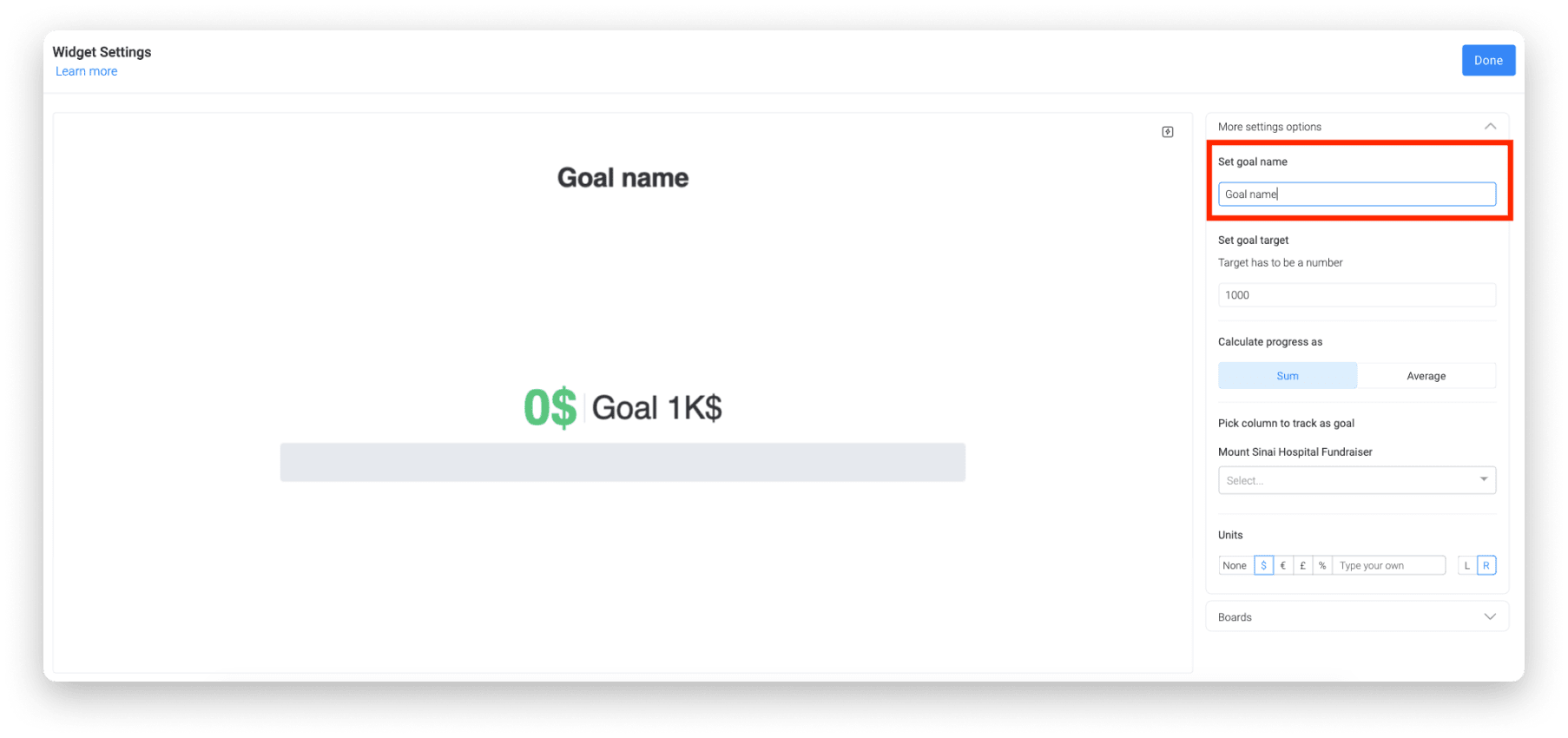
Create your roadmap to reach those goals
After setting your goals, it’s time to break them into milestones and deadlines so they’re more manageable and trackable.
When setting milestones, be specific. For example, you want to grow your customer base by X% or gain X net new customers for your “Basic” plan every month.
These give your sales team challenging but manageable goals to shoot for, motivating them to do their best.
You can break down overall milestones into individual team member targets too. Doing so can account for the disparity in sales rep performance.
For example, one sales rep might be better at prospecting than closing. Give them a milestone for monthly sales. A percentage of prospects would be a good goal for them.
Another salesperson might struggle to find leads, but be a killer closer. Assign them a certain number of new leads to generate each month. More leads at the same excellent conversion rate are lucrative.
Overall, your milestones and deadlines should push your sales team, but not be impossible to reach.
You can track milestones and progress in monday.com using one of our many customizable templates, such as this project milestones template:

Define and profile your ideal customer
Ultimately, the customer decides how well they think your product or service helps. Knowing them and what’s important to them is key to selling.
Create your ideal customer profile — also called a buyer persona.
With your ideal customer profile, you can lay out everything about the customer — dreams, desires, pain points, you name it. You’ll have a bountiful source of ideas for marketing campaigns, sales scripts, and so on.
Also, defining your ideal customer helps you qualify better prospects during lead generation. Sales reps can waste less time talking to bad prospects, improving sales efficiency.
Map your customer journey
Once you understand your customer, you can map out their journey from prospect to sale to loyalty. Knowing each stage of their journey helps you take the right actions.
There are several stages in the customer journey.

- Awareness: this is how customers find your brand — aka marketing channels.
- Consideration: here, you make customers more aware of their problems — and your solution — by informing them of your product/service with content.
- Decision/ Purchase: the customer decides whether to buy here. Facilitate the customer sale — make it fun and easy for them to hand you money.
- Retention: now, you have to keep your customers by providing excellent customer service.
- Advocacy: finally, you can turn your customers into “unpaid salespeople”, accelerating your progress towards sales goals.
Clarify your value proposition
Finally: how does your brand fit into your customer’s needs and stand above the competition?
Clarify your value proposition and competitive advantages. Find out why customers buy your type of product or service, and why they should choose you over the other company.
To do this, list all features of your products and services. Then, extrapolate those into benefits or, in other words, what your product does for your customer.
Finally, dimensionalize those benefits by creating a mental image for your customer in their mind about how much better things will be when they use your product or service.
For example, accounting software might offer recurring invoicing. The benefit to the customer of said software is they save time and reduce error while maximizing their revenue.
Then, you can dimensionalize it by getting the customer to imagine money coming in on autopilot, no longer triple-checking recurring invoices and worrying about errors, and so on.
Use the right tools
All of the plan’s components are in place. Time to make sure you have the right tools.
List all the tools you have at your disposal. Know what you can use to follow your plan and what you still need to get.
One of the most vital tools you’ll need is a CRM for recording and tracking your leads. Why not try out this Sales CRM template from monday.com to make your life easier?
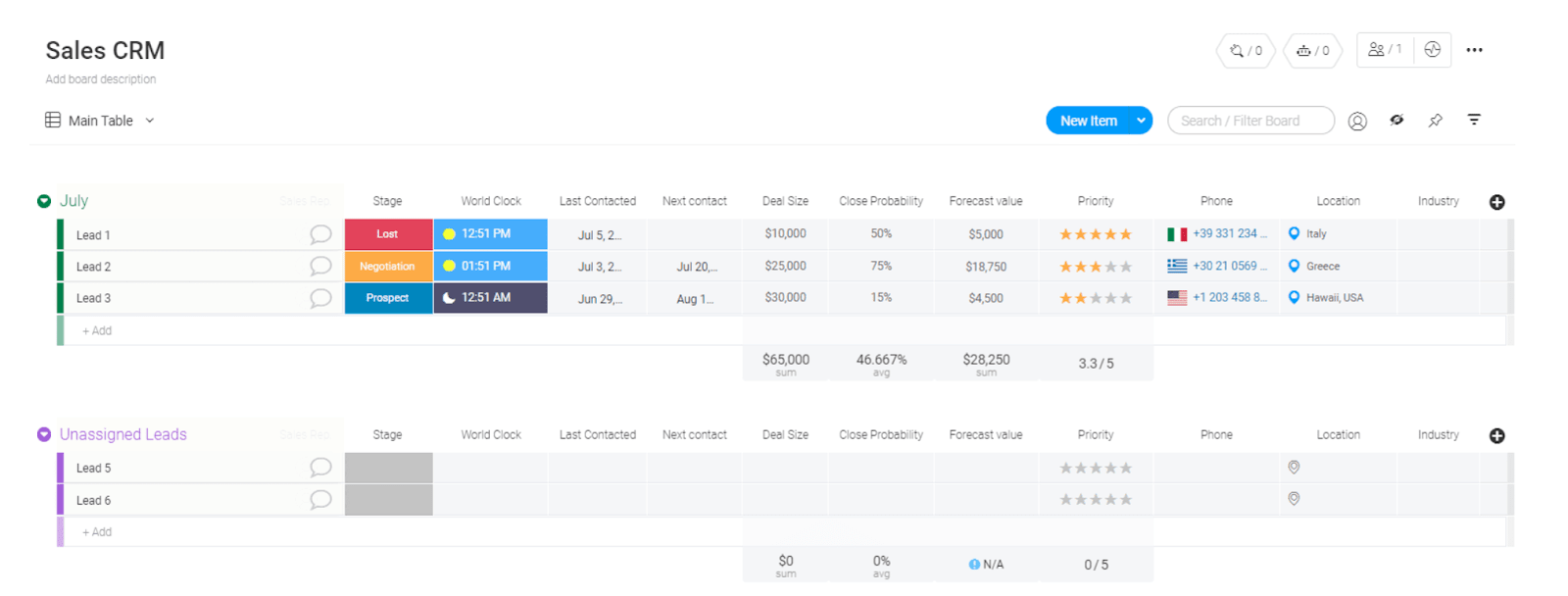
Find channel partners if necessary
If you decide a channel sales approach works best, you’ll have to find partners that work well with your business.
Complementary service providers are often the first choice in channel sales strategies. These are companies with a product or service that, as the name implies, complements yours.
For example, Company A is a payment processor. Company B is a Point-Of-Sales system manufacturer.
POS systems and payment processing services are a natural duo. Thus, Company B partners with Company A to sell its POS systems to Company A’s customers.
Know what to track (and make adjustments accordingly)
Your sales plan isn’t set in stone. You must monitor company performance to see how your plan is faring.
Track your KPIs with software containing reporting and analytics features. Compare your data against your milestones and see if you’re on track.
Also, have regular meetings — monthly at a minimum — to discuss sales progress and KPIs.
If you aren’t hitting plan expectations, try to find out why.
Perhaps your messaging is off. You might need to review your customer profile and make changes.
Maybe a channel partner isn’t the best fit. Reevaluate your partnership and see if it’s still worth the investment.
Gather feedback from all teams during meetings as well since they’re on the ground enacting the plan.
Keep track of everything in one digital location using this Meeting Notes template:
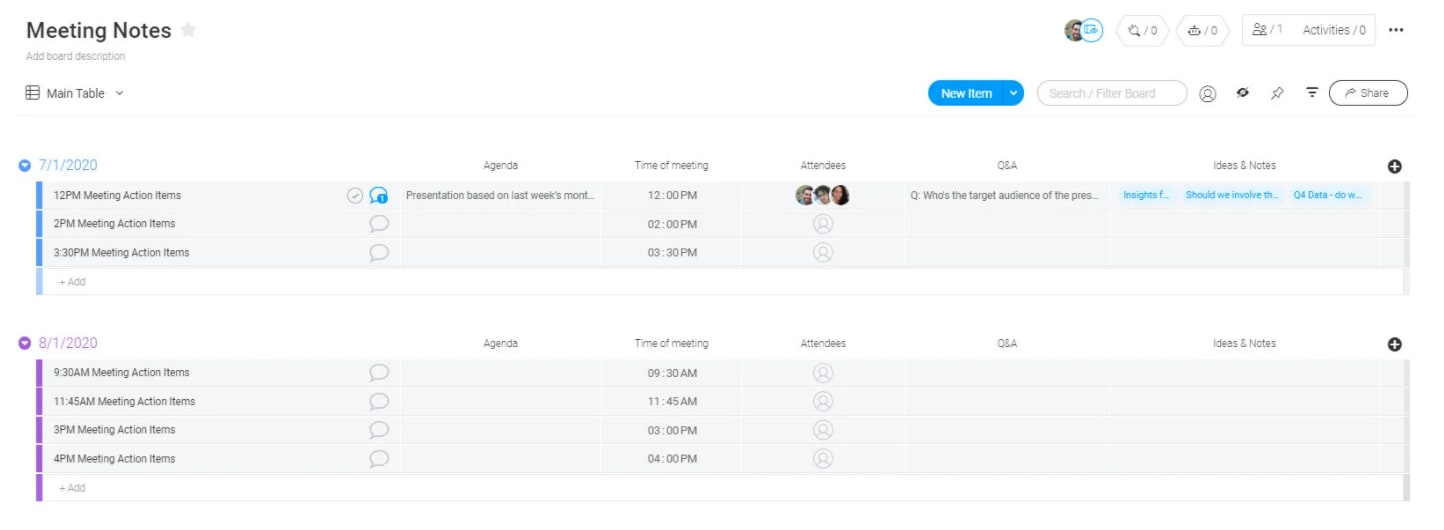
As you go along, modify your sales plan as needed.
Building a sales plan that converts with monday.com templates
monday.com offers plenty of templates that are useful for executing your sales plan. Check out some of the top templates below.
Sales process template
Just like with your sales plan, visualizing your sales process keeps your sales reps on the same page and boosts efficiency.
You’ll find monday.com’s highly customizable Sales Process template handy:
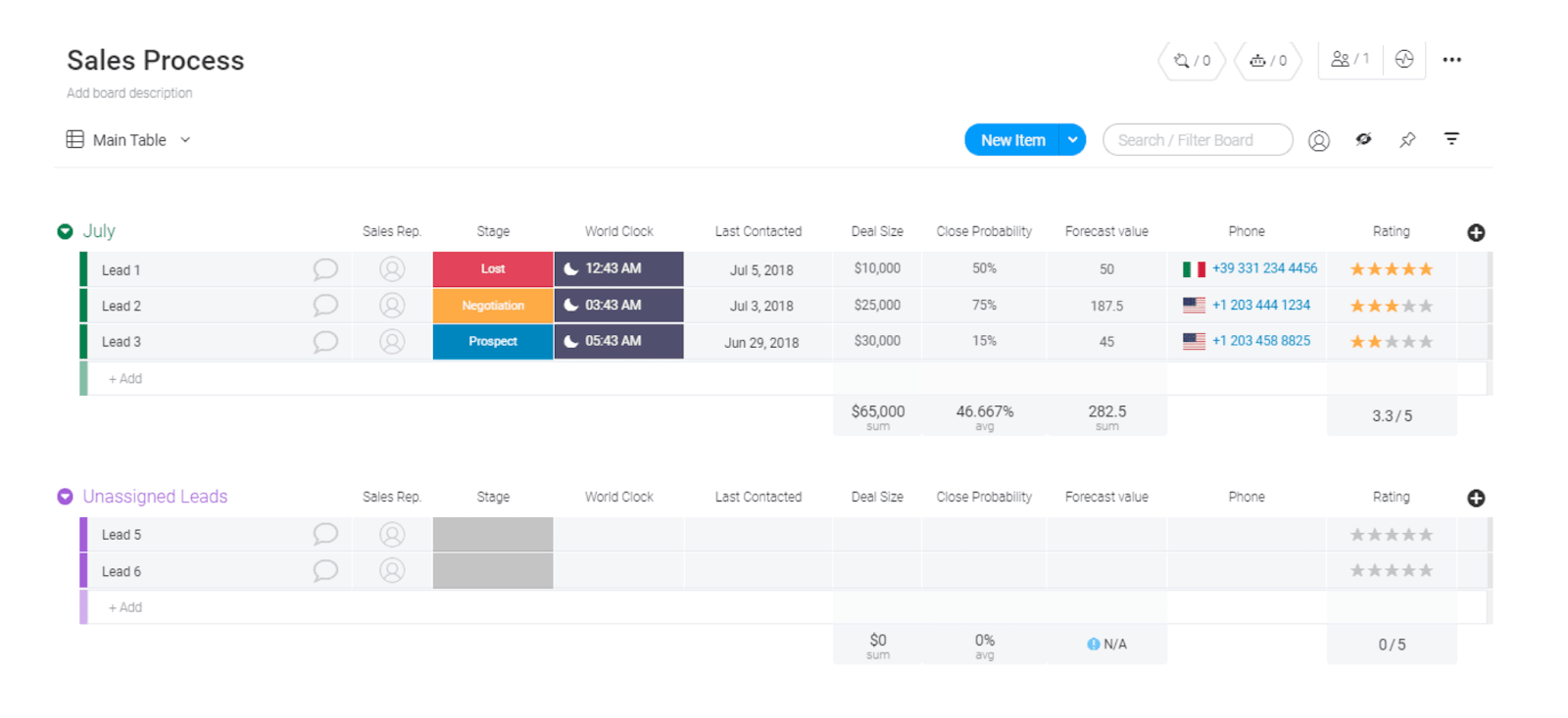
Sales pipeline template
Once you have your sales process, monitor your sales pipeline. It tells you where each lead is in the sales process so you — or your sales team — know what actions to take.
When you combine your sales pipeline with a sales funnel, you can look at the numbers: how many leads you’re generating, how many deals you’re closing, and more.
Plus, you can improve sales management by finding and fixing problems sales reps might run into on the job.
Keep tabs on your pipeline with this Sales pipeline template:

Marketing calendar template
To enact your broad sales plan, you need to plan and organize your marketing activities to bring in the necessary lead flow.
That’s what a marketing calendar is for.
Marketing calendars are especially helpful for implementing your content strategy.
So plan out your content and other marketing initiatives with this Marketing Calendar template.
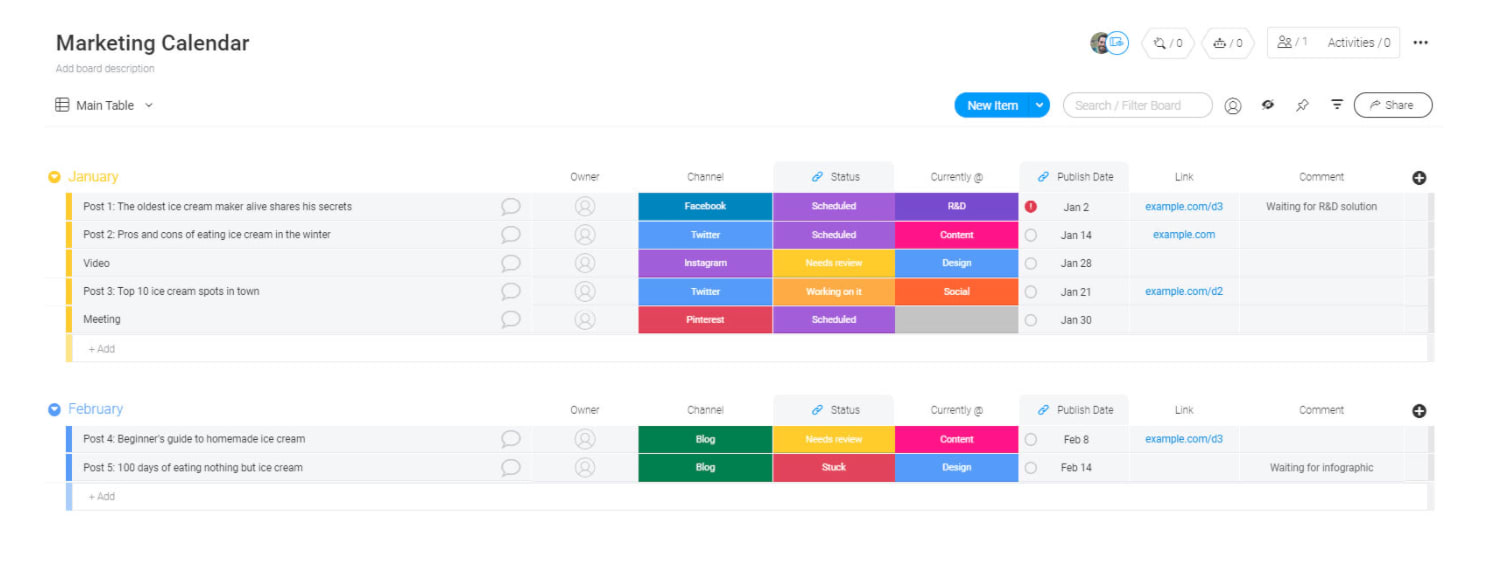
If you want, you can shift to the calendar view with ease. Which helps you assess upcoming deadlines.
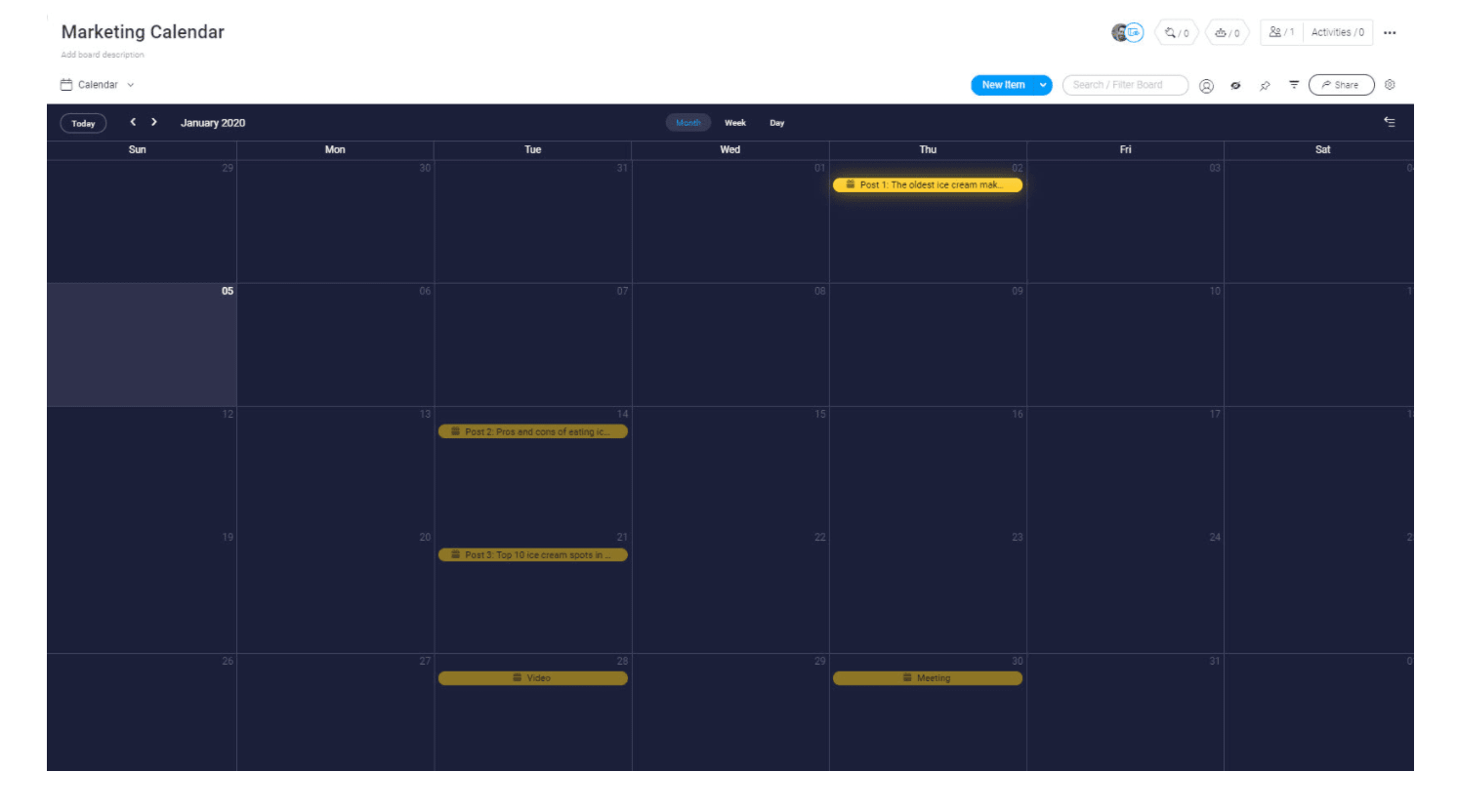
Campaign tracking template
To see how the marketing side of your plan is performing, track campaign performance.
You can use the data to inform changes to your sales plan, marketing calendar, and even your buyer persona.
Try out monday.com’s Campaign Tracking template to know the numbers on your marketing campaigns.
![]()
Competitors analysis template
You have to learn your competitors’ value propositions and competitive advantages to clarify your own.
This involves doing some competitor analysis.
Comparing competitors against each other helps you see patterns, too, which can be useful when combined with buyer persona research.
For example, your competitors are all hitting on certain pain points in their marketing, but you’ve identified a key pain point that they aren’t.
If you can link your value proposition and benefits to this pain point, you just unlocked a lot of potential loyal customers.
Analyze and compare your competitors against each other and yourself with this Competitors Analysis template:
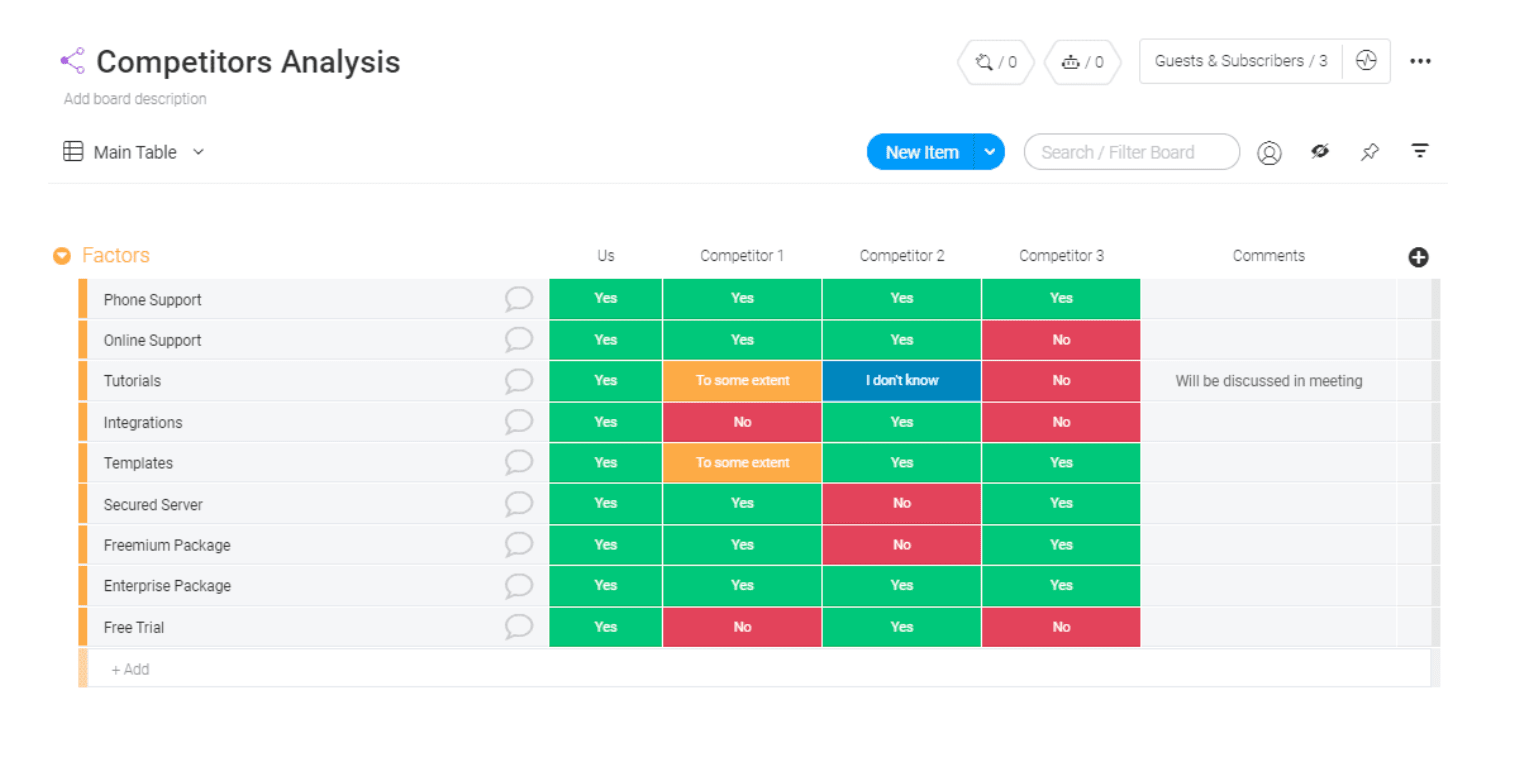
Planning makes perfect
“Failing to prepare is preparing to fail” is common advice you’ll hear from plenty of successful people, and sage advice it is. If you hope to meet and exceed your sales targets, you’ll need a solid plan for doing so.
But don’t do your sales plan on paper, and don’t keep each component separated among numerous software tools. Instead, build it all inside one Work OS. Sign up for monday.com today to see how easy it’ll make your sales planning.


